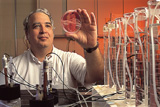ETHANOL: Energy Alternative
 Lonnie Ingram has been touting the
benefits of ethanol for a long time. It was his belief in ethanol as an
alternative fuel that prompted him to experiment with genetic engineering
to develop a microbe that would ferment feedstock like corn stalks and
cobs into ethanol, adding to the ethanol already produced from the corn
itself.
Lonnie Ingram has been touting the
benefits of ethanol for a long time. It was his belief in ethanol as an
alternative fuel that prompted him to experiment with genetic engineering
to develop a microbe that would ferment feedstock like corn stalks and
cobs into ethanol, adding to the ethanol already produced from the corn
itself.
He lobbied for ethanol as a viable alternative to gasoline at a Washington, D.C. ceremony in 1991 when the U.S. Patent and Trademark Office honored his work at the University of Florida with the nation's landmark five-millionth patent.
And he argued for ethanol last October, when BC International Corp. broke ground on a $90-million plant in Jennings, La., which will be the world's first commercial facility for manufacturing ethanol from organic waste when it is completed early in 2000.
Specifically, the Louisiana plant will use bagasse, the cane stalks and residues from sugar refining, as a raw material. The plant expects to produce about 20 million gallons of ethanol annually.
There's nothing new about creating ethanol. People have been using yeast to create ethanol for thousands of years, but the raw material always had to be a high-value crop like corn or sugar that was worth more as food than it was as a fuel alternative.
Ingram's microorganism changed that, producing ethanol from woody materials like bagasse, corn stalks, rice hulls and yard/wood wastes.
"Until we developed this new technology, the chemical complexity of biomass prevented it from being used to make ethanol economically," says Ingram, a distinguished professor of microbiology and cell science and a UF Research Foundation Professor. "The process is still rather complicated and the equipment is costly, but ethanol is clean burning, renewable and environmentally safer than petroleum products."
The bacteria Ingram works with, including the common E. coli, very efficiently ferment sugars in all plant material but normally produce acetic and lactic acids as fermentation products. By inserting the Zymomonas mobilis genes for ethanol production, Ingram was able to redirect the digestive processes of these organisms to make ethanol instead of acids.
"The new technology will allow ethanol to become economically competitive with fossil fuels for the first time," Ingram says.
Ingram's research is supported by the U.S. Department of Agriculture and Department of Energy. UF has granted BC International, based in Dedham, Mass., exclusive rights to use and license the UF-engineered bacteria, dubbed K011.
"With this new technology, we can provide a source of energy by utilizing waste from farm crops instead of the crops themselves," says BC International Executive Vice President Clinton Norris.
U.S. Department of Energy funding of $11 million began under a 1996 agreement with BC International to commercially demonstrate the production of ethanol from biomass resources, which include agriculture and forest waste, municipal solid waste and dedicated energy crops. This project, funded by the department's Office of Energy Efficiency and Renewable Energy, is the first in a series of commercial demonstrations to help establish this emerging technology.
"This facility is a giant step toward alternative fuels that are domestically produced and based on renewable, low-polluting energy sources," U.S. Energy Secretary Bill Richardson said on the day BC International broke ground on the Louisiana facility. "We can look forward to a day when a ton of biomass will be traded like a barrel of oil is today.
Currently, the United States consumes about 120 billion gallons of automotive fuel each year. Fuel ethanol from corn is blended with about 10 percent of this gasoline to improve octane ratings and burn cleaner.
"There are enough agricultural and timber residues to completely replace gasoline in the United States and in many other countries," Ingram says.